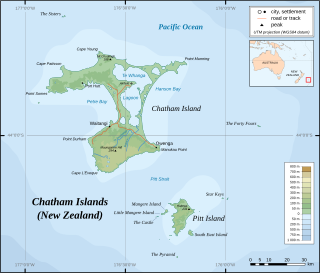
Hokorereoro, Rangatira, or South East Island is the third largest island in the Chatham Islands archipelago, and covers an area of 218 hectares. It lies 800 kilometres (497 mi) east of New Zealand's South Island off the south-east coast of Pitt Island, 55 kilometres (34 mi) south-east of the main settlement, Waitangi, on Chatham Island.
The flora of the Chatham Islands consists of around 388 terrestrial plant species, of which 47 are endemic. The Chatham Islands make up the Chatham floristic province of the Neozeylandic Region of the Antarctic Kingdom.
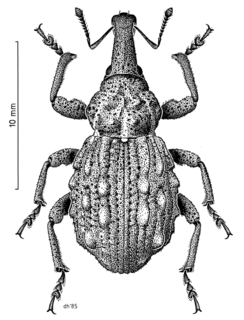
Hadramphus tuberculatus is a rare weevil endemic to Canterbury in the South Island of New Zealand. It was thought to be extinct in 1922 but was rediscovered in 2004.

The Chatham parakeet(Cyanoramphus forbesi), also known as Forbes' parakeet, is a rare parakeet endemic to the Chatham Islands group, New Zealand. This parakeet is one of New Zealand's rarest birds and is classified as Vulnerable on the IUCN Red List, as a result of a range of threats to the species survival, including habitat loss, predation, and hybridization. A number of conservation methods have been employed to assist the recovery of this species, and currently the population trend is considered stable.

The Chatham shag, also known as the Chatham Island shag, is a species of bird in the cormorant and shag family, Phalacrocoracidae. It is endemic to the Chatham Islands of New Zealand. For a long time the species was placed in the genus Phalacrocorax; today it is mostly placed with the other blue-eyed shags of New Zealand and Antarctica in the genus Leucocarbo. Its closest relative is the Otago shag of South Island.

Xylotoles costatus, the Pitt Island longhorn beetle, is a species of beetle in the family Cerambycidae. It is endemic to the Chatham Islands. Once thought to be extinct, it is now known to survive on South East Island/Rangatira; being therefore an example of a so-called "Lazarus taxon".

Hadramphus, commonly known as knobbled weevils, is a genus of flightless molytine weevils from the family Curculionidae. It is endemic to New Zealand and consists of four species.
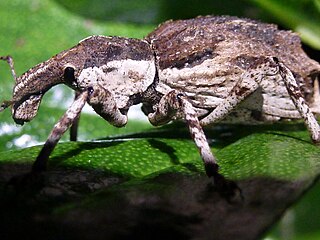
Anagotus stephenensis, commonly known as the ngaio weevil, is a large flightless weevil that is only found on Stephens Island in New Zealand. The ngaio weevil was discovered in 1916 by A.C. O'Connor on Stephens Island. Thomas Broun described it in 1921 as Phaeophanus oconnori after its collector. The weevils were observed at the time to be 'feeding on tall fescue and the leaves of trees'.

Anagotus fairburni or flax weevil is a large flightless weevil. It feeds on leaves of New Zealand flax species where it produces a characteristic feeding notch. It is found on islands and in alpine areas of New Zealand.
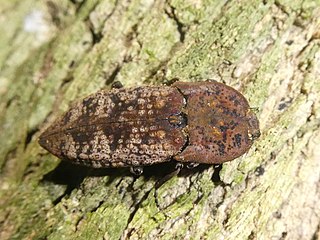
Amychus granulatus, commonly known as the Cook Strait click beetle, is a large flightless click beetle in the family Elateridae.

Dolomedes schauinslandi or the Rangatira spider is a large spider of the family Pisauridae. It is only found on South East Island (Rangatira), Houruakopara and Mangere Islands in the Chatham Islands, New Zealand. It is one of New Zealand's largest and rarest spiders.
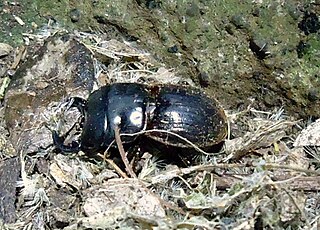
Geodorcus capito is a large flightless species of stag beetle in the family Lucanidae. It is endemic to the Chatham Islands in New Zealand.
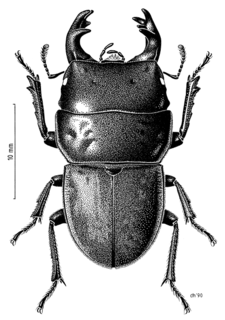
Geodorcus ithaginis, the Mokohinau stag beetle, is a large flightless species of stag beetle in the family Lucanidae. It was described by Thomas Broun in 1893 after being discovered in the Mokohinau Islands by Andreas Stewart Sandager, a lighthouse keeper on the islands. The species survives only on the small unnamed island "Stack H", in a patch of vegetation the size of a living room, and is in extreme danger of extinction.

Geodorcus sororum is a large flightless species of stag beetle in the family Lucanidae. It was discovered in 1973 by Mr. A. Wright on an expedition to Middle Sister Island/Te Awanui, one of The Sisters Islands/Rangitatahi which are part of the Chatham Islands in New Zealand. This holotype specimen is held in the New Zealand Arthropod Collection. It was first described by Beverley Holloway in 2007. The name sororum is translated from Latin to mean "belonging to the sisters".

Austramathes squaliolus is a species of moth in the family Noctuidae. It is endemic to New Zealand and is found only in the Chatham Islands on the Chatham, Pitt, Little Mangere and Rangatira Islands. The larvae of A. squaliolus is similarly patterned to the larvae of A. fortis and have lateral yellow markings that contrast with the dark dorsal marbling. However this marbling is darker in A. squaliolus in comparison to the lighter coloured A. fortis. Melicytus chathamicus is the larval host-plant for this species. The adult moth is again very similar in appearance to A. fortis and, as with A. fortis, the black line curved at the forewing base is the distinguishing feature. However the two species are unlikely to be confused as their ranges do not overlap. The adult moths are on the wing in November and December and have been observed flying at dusk.

Lyperobius huttoni is a New Zealand weevil found in alpine areas of the South Island and at sea level around the Wellington coast. It feeds only on speargrass (Aciphylla). Weevils from the endangered Wellington population have been translocated to predator-free Mana Island.

Lyperobius hudsoni is a flightless weevil found in alpine areas of Central Otago and Otago Lakes in the South Island of New Zealand.
Creophilus rekohuensis is a beetle of the Staphylinidae family, subfamily Staphylininae. This species occurs only on some small predator-free islands in the Chatham Islands, New Zealand, where it lives in seabird burrows. Its name derives from Rekohu, the Moriori name for Chatham Island.
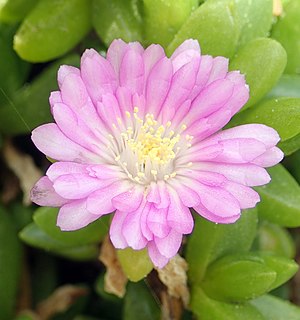
Disphyma papillatum, commonly known as Chatham Island ice plant, is a species of flowering plant in the family Aizoaceae and is endemic to the Chatham Islands of New Zealand. It is a succulent, prostrate herb with flattened, pimply, trailing stems, leaves that are triangular in cross-section, and white to pink, dark blue or purple daisy-like flowers.

Carex ventosa, also known as Chatham Islands forest sedge, is a tussock-forming species of perennial sedge in the family Cyperaceae. It is native to the Chatham Islands.




















